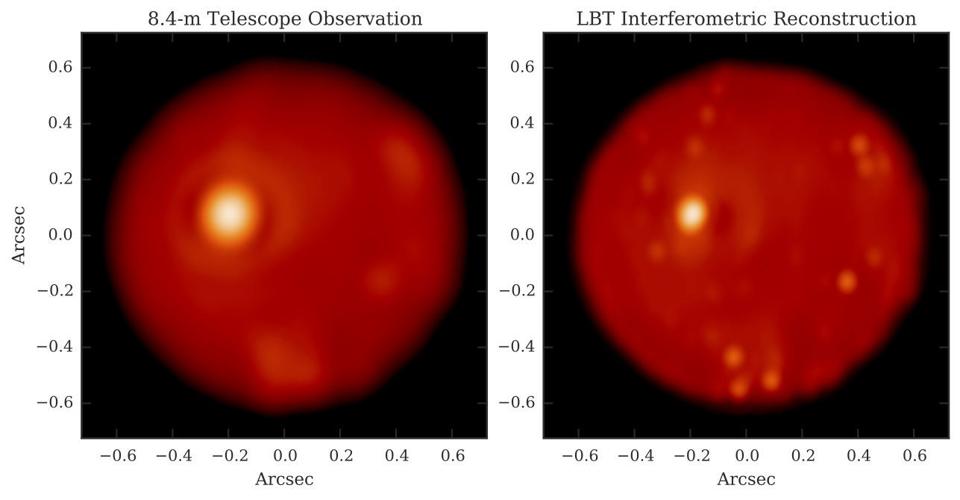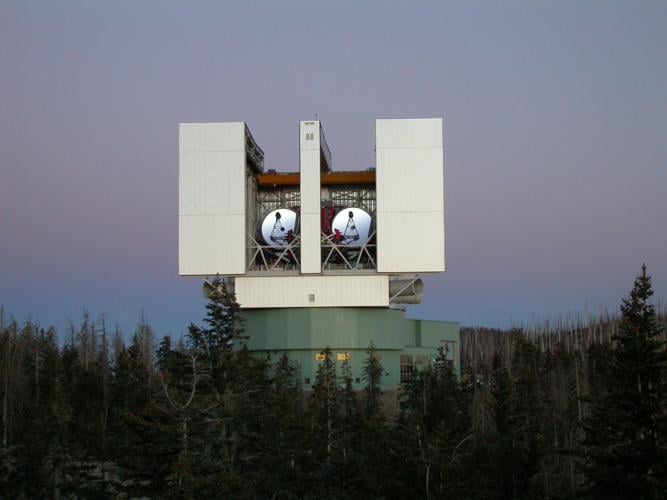Astronomers at the Large Binocular Telescope (LBT) on Mount Graham have published images of volcanoes and magma basins on Jupiter’s moon Io with a clarity previously unattainable from a ground-based telescope.
It produced more evidence for a theory that a suspected lava lake called Loki was forming a crust and then sinking to reveal magma.
Imke de Pater, a professor of astronomy and planetary science at the University of California at Berkeley, said the LBT images clearly showed hot spots in the giant lava lake at different locations.
She said she had never been able to detect more than a single light source, using the largest telescopes on Earth.
“With the higher resolution you get a lot more details of the source,” she said. “We see there are two bright spots in that circular or horseshoe-shaped lake and we’ve never seen that from the ground before.”
The trick now, said LBT director Christian Veillet, is to turn a “race car” of a telescope into a “commuter car” — routinely producing the cutting-edge astronomical observations that have eluded the LBT during the first decade of its operation.
The Io paper was published Thursday in the Astronomical Journal.
The Io observations, and other recently published results on exoplanets and dust rings around distant stars, demonstrate that light from the two large (8.4-meter diameter) mirrors of the LBT can be effectively combined into a single image with the clarity you would get from a telescope 22.8 meters in diameter.
Critical to that was development of the Large Binocular Telescope Interferometer (LBTI), which combines light collected by the two mirrors and “interferes” the light waves to reveal more detail in the targeted objects.
Interferometry can also be used to “null” or erase unwanted parts of the image. Nulling is used to block the light from a star while resolving exoplanets and dust rings that orbit it.
Steward Observatory astronomer Phil Hinz led development of the LBTI under a NASA grant that targets nearby stars.
That program, called HOSTS, the Hunt for Observable Signatures of Terrestrial Systems, is looking for “warm, dusty material around other stars,” Hinz said.
“NASA would like to fly a (space telescope) mission looking for other earths. They need to know ‘Do other systems have dusty material in the habitable zone that might prevent that mission from being successful?’”
Initially, Hinz and his team will use 30 nights of viewing time on the LBT over the next two years to identify or exclude targets for that future NASA mission, “with a discussion about extending it.”
Just this week, the project was given a “pass” to begin that program by an independent review team convened by NASA, Hinz said.
NASA wanted to be assured that the HOSTS observations could be done reliably and efficiently, said Hinz. It still has a few technical kinks, but has been functioning reliably, he said.
Al Conrad, principal investigator for the science team observing Io, said his observing runs on LBTI went off with few hitches. “I’ve been an observer for a long time, and I’m not unrealistic. It was smooth,” he said.
Conrad called the near-infrared images captured by the LBT’s LMIRCam “a crowning achievement for decades of work by a number of different individuals.”
Conrad, a scientist at the LBT observatory, said the team has continued to observe Io and recently caught Jupiter’s moon Europa passing in front of it.
That produced a bonus set of data that will be written up in an upcoming paper. The team included a video of the Europa/Io occultation with its news release this week as an illustration of the telescope’s power to resolve distant features.
Io is 390 million miles from Earth. Watching the passage of Europa in such detail was “just stunning,” said Conrad.
The LBT was always meant to work as a 23-meter telescope, but it lacked the hardware to make that possible for the first decade of its operation.
First, both eyes of the telescope had to be fitted with “adaptive” secondaries — ultra-thin mirrors with hundreds of magnetic “actuators” that deform the mirror to erase the effects of atmospheric blurring.
Astronomers from Steward worked with partners at two research institutes in Italy to create and install the adaptive optics. The second AO mirror wasn’t commissioned until 2011.
Then the interferometer had to be installed and commissioned. That happened at the end of 2013, and the science being written up now hails from that time period.
Institutions and universities in Germany, France and the United States, including the University of Arizona, are partners in the Large Binocular Telescope, which is located in the Pinaleño Mountains southwest of Safford.






